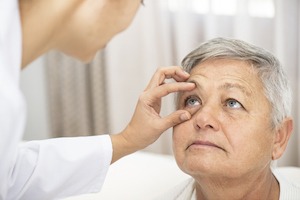Written by Olivia Cohen
By the age of 65, nearly one in three people has some sort of age-related vision loss, making it one of the most common conditions facing our maturing population. Although vision loss creates obstacles to daily functioning, it is easy to prevent through regular screenings and early treatment. Read on to learn about the four most common types of vision loss in mature Americans.
Age-Related Macular degeneration
Age-related macular degeneration is the leading cause of vision loss among people aged 65 or older. The condition affects the macula, which is located at the center of your retina and helps you see close up for activities such as reading, sewing, and writing. Although the exact cause of macular degeneration is unclear, it is sharply correlated with age, with most cases developing after age 50. Family history, smoking, high alcohol use, sunlight, obesity, and high blood pressure and heart disease are also possible risk factors, although studies are limited.
Signs of macular degeneration include seeing shadowy areas in the center of your vision, not seeing what’s right in front of you, or otherwise fuzzy or distorted vision. The process is slow and pain-free, and although there is no known cure, treatments such as laser work, injections, and dietary changes can delay progression and improve vision.
Glaucoma
Glaucoma is another leading cause of vision loss among Americans, accounting for one in every seven or eight cases of blindness. Glaucoma results from fluids building up inside the forward part of the eye, creating excess pressure that damages the optic nerve. This results in blurred vision, a narrowed field of sight, and eventually total blindness.
Open-angle glaucoma typically doesn’t have any early warning signs, and is best caught through regular eye exams. Acute angle-closure glaucoma has noticeable symptoms like hazy vision, rainbow-colored circles around bright lights, and severe eye pain. If you experience any of these symptoms, seek prompt medical care.
If caught early, glaucoma can be managed with medication; occasionally surgery is necessary.
Cataracts
Cataracts are a common form of vision loss and the leading cause of blindness worldwide, although they are easily treated in the United States and other developed countries. Cataracts present as as opacities that interfere with vision, often progressing slowly and painlessly. Symptoms of cataracts include blurred vision or glare, and are strongly correlated with age, with roughly 50% of people over the age of 75 experiencing cataracts.
Cataract surgery is a common surgical procedure that is effective in treating cataracts, and it is covered by Medicare.
Diabetic Retinopathy
Diabetic retinopathy is the leading cause of blindness among middle aged Americans, and is also coming among more senior populations. The likelihood of developing diabetic retinopathy rises with the duration of diabetes. There is a milder form of retinopathy that usually does not cause serious vision loss, but may cause blurry vision.
Those with diabetes should get their eyes checked regularly, as early identification and treatment can prevent more serious vision loss.
If your loved one needs help performing daily tasks as a result of vision loss, consider bringing a qualified care provider into your home. American In-Home Care always refers qualified, screened, care providers that are compassionate and ready to help. Contact us at 1-844-505-0004 to schedule your free in-home consultation to discuss which care options are right for you and your family.


